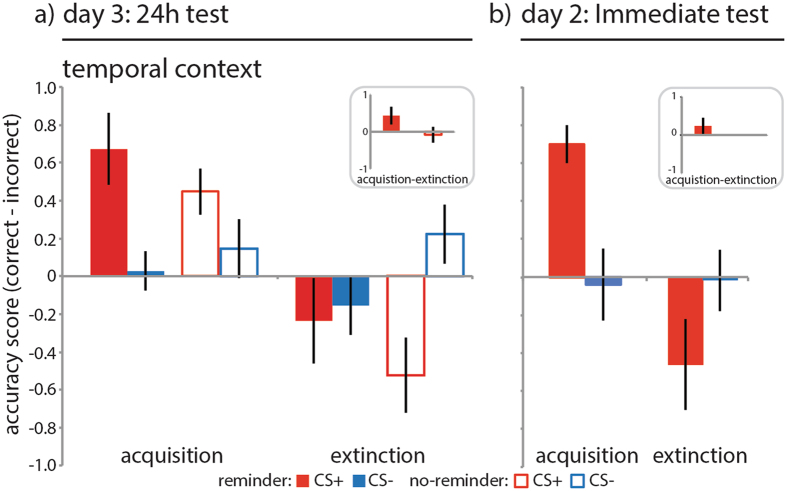Figure 3.
Results context memory. An isolated reminder resulted in better memory for the temporal context of items from the CS+ category. Reminder group (solid bars, N = 18), no-reminder group (open bars, N = 20), CS+ (red), CS− (blue), acquisition = items that were presented during acquisition, extinction = items that were presented during extinction, error bars reflect SEM. Follow-up one sample t-tests revealed that participants accurately indicated CS+ items from acquisition to be from day 1 (t(37) = 5.045, p < 0.001), but also inaccurately indicated CS+ items from extinction to be from day 1 (t(37) = −2.614, p = 0.013), and were not able to differentiate CS− items from acquisition (t(37) = 0.947, p = 0.350) and extinction (t(37) = 0.388, p = 0.701). Follow-up paired samples t-test revealed a difference in memory performance between CS+ items from acquisition and extinction (t(37) = 4.322, p < 0.001; CS+ acquisition: 0.5533 ± 0.1097; CS+ extinction: −0.388 ± 0.1485) but no difference for CS− items (t(37) = 0.290, p = 0.773; CS− acquisition: 0.0894 ± 0.0945; CS− extinction: 0.0441 ± 0.1137). Follow-up independent samples t-tests on temporal context memory scores averaged across CS+ items from acquisition and extinction (inset) revealed better memory in the reminder group than in the no-reminder group for the CS+ at trend (t(36) = −1.845, p = 0.073; no-reminder: −0.0395 ± 0.0778; reminder: 0.2128 ± 0.1193). (b) The reminder immediate test group (right panel, solid bars, N = 16) was able to accurately indicate the source of CS+ items from acquisition (t(15) = 7.114, p < 0.001: 0.7489 ± 0.1052) but not extinction nor did they inaccurately indicated items from extinction to be from acquisition (t(15) = −1.728, p < 0.105; reminder immediate group: 0. −0.4584 ± 0.2653) revealed by one-sample t-test. Averaging across CS+ trials from acquisition and extinction revealed that the reminder extinction group was overall not able to discriminate the source of items correctly (t(15) = 1.223, p = 0.240: 0.1452 ± 0.1188).

